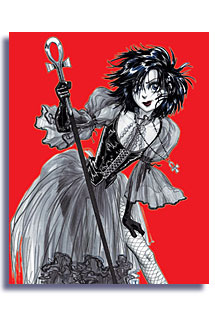| Death:
At Death's Door
Japanese
comic books, along with cartoons and merchandise, have become
an intrinsic part of the American book market, as well as
the U.S. comic book industry. Slews of comic book artists
have embraced traditional manga art conventions (speed lines,
larger than possible eyes, etc.) and have even formed a subset
of comic art: "amerimanga" if you will.
The popularity
of manga in American bookstores and comic shops may be what
puts the nail in the coffin of the American comic book industry,
or it might save it. Manga appeals to the younger generations
because many tie directly into popular children's shows like
Yu-Gi-Oh! or Pokemon, so those little ankle
biters scurry on over to the bookstore and grab copies of
whatever the latest trend or fad is. While they're there,
they notice some of the other titles in an ever-growing manga
section in the Graphic Novels aisle, and begin picking these
up.
So essentially,
these kids are reading comic books at an early age, liking
them, and continuing to read and buy more of them. This is
a damn good thing in an industry where it is next to impossible
to interest the younger generation in anything comic book
related, thus creating a future fan base and an economic windfall.
Problems
arise when it comes to cross-pollination: kids who read manga
rarely crossover and begin reading American comic books. It's
an understandable stopping point, because of the drastic change
in form that would occur during the crossover. Manga is printed
in black and white, drawn in a specific style, and at times
even printed backwards (in the traditional Japanese fashion,
which is great for those few "otaku" who like the
idea, but infuriating to the adult comic book fan looking
to get into manga).
As of
late, comic book publishers have been trying to make the leap
from manga to American a little less of a jump, and one of
those attempts is Jill Thompson's Death: At Death's Door
from DC's Vertigo imprint.
It's the
story of Death (the quirky, loves-everyone anthropomorphic
personification of the Grim Reaper as a concept) and her two
Endless siblings, Despair and Delirium, as they deal with
a Hell that has been closed. When the lost souls of Hell show
up literally at Death's door looking for a place to wait until
they get sent to heaven, figuring they've fulfilled their
punishments, things get out of hand.
It seems
that Lucifer is tired of running the shop and gives up ownership
of Hell to Dream (sometimes called Morpheus), who is searching
for a long lost love that he sentenced to Hell out of spite
for her rejection. Dream now owns Hell, and a representative
from every walk of creation, from demon to a cardboard box
(who is really the personification of Order, mind you) to
Heaven itself, is vying for a chance to decide what the new
Hell will be. Meanwhile, Death has to attempt to keep things
under control at her place, while still performing her "soul"
profession.
The book
is printed in a smaller digest form, and the artwork by Thompson
is all done in the manga/anime style. In fact, if I didn't
know that Thompson wasn't some pseudonym for a Japanese artist,
I would swear the art for this book came straight from the
land of the rising sun.
The art
is very good and Thompson weaves it well with the story from
above. I'll admit that I do like the manga art style up to
a point, and I've always liked seeing different artists' takes
on characters I am already familiar with.
The story
itself is fine; it is mostly a rehashed plotline from Neil
Gaiman's fourth volume of Sandman, Season of Mists,
with more of a focus placed on what was happening to Death
and her sisters, instead of Dream and his search for the woman
he condemned to Hell.
And that
may be a problem. DC's intention with this piece is obviously
to attract some of those manga readers to their product, but
they've chosen the wrong material with which to do it. I remember
reading my first volume of Sandman and I don't remember
it being extremely easy to understand the "anthropomorphic
representations of the human condition" all of which
started with "d" thing.
I can't
imagine what a ten-year old would think when picked up this
book and tried to make his way through the high concepts involved,
not to mention the fact that the reader is just thrown into
the continuity of these characters with only the briefest
of explanations of what, who, and why they are who they are.
If I didn't have some grounding in the Sandman universe, I
would be completely lost when I read this. I still don't know
why Destruction is the only sibling who doesn't come to Death's
initial party, or why he's missing, and the book gives the
reader no hope of closure to those dangling plot threads,
All
in all, it's pretty much a companion piece to the Sandman,
Death, and Endless series from Vertigo, and will
really only appeal to those that follow(ed) these titles.
It fails, despite a noble effort by Thompson, to be accessible
to it's target audience (the 8-14year olds), and is only worth
shelling out the $9.95 for if you are already a fan.
It was
a noble effort to recapture the market, DC, but please, try
again and with something that doesn't require knowledge of
mature themed continuity that a middle-schooler is likely
to lack.
|






